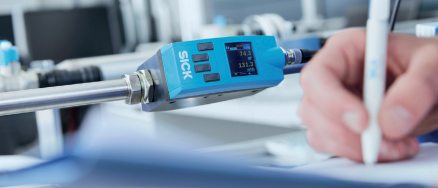A hiss is as good as a mile…?

Walk onto a shop floor in the early morning, before the machines start up and workers arrive, and an eerie sound of hissing pervades the silence. It’s the unmistakable sound of compressed air leaks – and of your company’s cash quite literally disappearing into thin air.
It’s estimated that manufacturers waste around 30% of the compressed air they generate.1 But tracking down and fixing leaks can be a laborious, hit and miss affair. Even with a modern energy management system in place, a maintenance team might only survey the plant every three or six months. Yet, compressed air accounts for 10% of energy use in a typical operation, rising to 30% in heavy-use industries.
Small leaks multiply
A single 3mm hole could cost more than £4000 a year in electricity. Multiple, smaller leaks are most common, yet, once located, they are quickly and easily fixed. Nevertheless, compressed air is all too often overlooked. If the pressure drops, it’s tempting to turn up the power – increasing the load on the compressor, and probably pushing more waste out from the weakest points. Fluctuations in pressure also compromise the efficiency of the pneumatic machinery itself; the compressor’s service life will be shorter, there will be more unplanned maintenance and downtime.
The British Compressed Air Society2 (BCAS) recommends a target for a wellmaintained system should be around 5- 10% of air generated lost to leakage, but rates on an unmanaged system could be 40-50% of the generated output. BCAS recommends a number of actions to reduce surplus consumption including:training staff to change their behaviour; having a ‘listen, look and detect’ system, or using portable equipment to detect pressure differences.
To be sufficiently robust, permanent instrumentation is clearly desirable, especially if it can help narrow down the location of possible leaks and provide ongoing data. However, a range of measuring devices have been necessary to determine flow, pressure and temperature.
Tracking power demand across a compressed air system has then been a matter of taking these values and performing a manual calculation.
Measuring power demand
Although power demand at the compressor is easily measured, having a real-time, instant shop-floor reading of the actual compressed air energy being expended has not really been possible. At SICK, we spotted an opportunity to use dynamic calorimetric measuring technology to design a new kind of thermal flow meter: The SICK FTMg measures flow, pressure and temperature simultaneously, then uses an on-board algorithm to calculate the energy of gas passing through the flow channel in kWh.
By comparing the electrical power demand of the compressor with the energy of the gas as it flows, changes in the efficiency of a compressed air system can be identified, thereby detecting leaks in pneumatic systems and providing efficiency and energy consumption datain real time. Using one of more FTMg flow meters, interventions can be planned to identify and eliminate leaks by strategically placing the instruments on a machine cell compressed air system, or on a sub-ring of the delivery system, for example.
All this information is available in real time via dashboard read-outs, accessed via a mobile phone, PC or through the PLC control system, as well as via IT or cloud-based systems. Up to eight process parameters can be output: flow speed, flow volume, cumulative volume, mass flow, cumulative mass, energy consumption, current pressure, and temperature.
According to the Carbon Trust, UK industry uses over 10TWh of electricity a year to compress air 1 – equivalent to almost 1.5 power stations. It’s not just the wasted energy, that usage equates to 5 million tonnes of CO2 emissions.
Manufacturing industry is facing unprecedented challenges both of economic recovery and carbon reduction. Wasted compressed air adds up to huge energy costs and carbon emissions that can be easily fixed.
1. Carbon Trust, Compressed air,
Opportunities for Business (2012).
2. British Compressed Air Society Reducing
-
PPMA 2025
23 September, 2025, 9:30 - 25 September, 2025, 16:00
NEC, Birmingham UK -
Advanced Engineering Show 2025
29 October, 2025, 9:00 - 30 October, 2025, 16:00
NEC, Birmingham UK










